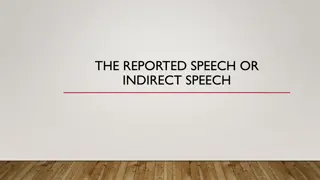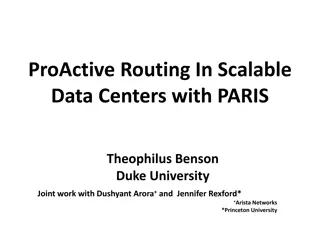Evolution of Practice-Based Research Networks: Past, Present, and Future
Explore the history and development of Practice-Based Research Networks (PBRNs) through key milestones and pioneers in the field from the pre-PBRN era to modern advancements. Discover the transformative journey shaping the landscape of healthcare research and collaboration in primary care settings.
Download Presentation

Please find below an Image/Link to download the presentation.
The content on the website is provided AS IS for your information and personal use only. It may not be sold, licensed, or shared on other websites without obtaining consent from the author.If you encounter any issues during the download, it is possible that the publisher has removed the file from their server.
You are allowed to download the files provided on this website for personal or commercial use, subject to the condition that they are used lawfully. All files are the property of their respective owners.
The content on the website is provided AS IS for your information and personal use only. It may not be sold, licensed, or shared on other websites without obtaining consent from the author.
E N D
Presentation Transcript
WRENs 2014 Convocation Glacier Canyon Lodge Wilderness Hotel & Resort Wisconsin Dells, WI September 17-19, 2014
PBRNs: Past, Present and Future John Hickner, MD, MSc Chair, Family Medicine University of Illinois at Chicago School of Medicine
Outline Past Present Future Context and Change
The Times They Are A Changin Come gather 'round people Wherever you roam And admit that the waters Around you have grown And accept it that soon You'll be drenched to the bone. If your time to you Is worth savin' Then you better start swimmin' Or you'll sink like a stone For the times they are a-changin'
GP pioneers of practice based research Sir James Mackenzie (1853-1925) Discovered PVCs Will Pickles (1885-1969) Epidemiology in Country Practice John Fry (1922-1994) Common Diseases Frances Huygen (?) Family Medicine: The Medical Life History of Families Curtis Hames (1920-2005) Evans County Cardiovascular Studies
The pre-PBRN Era Australian National Morbidity Survey 1962-1963 Canadian Influenza Surveillance Network, early 1970s UK: The Oxford Record Linkage Study, 1974 Dutch Sentinel Stations 1970 Weekly reporting of 1% of GP encounters 30 studies by 1979
Early PBRNs in the United States Family Medicine Information System Colorado, 1970s Dartmouth COOP Project 1978 Smiley face pain scale Ambulatory Sentinel Practice Network 1981 Pediatric Practice Research Group 1984 Pediatric Research in Office Settings 1985 Other regional networks in MI., MN., WI. in mid 1980 s WReN 1987!
Characteristics of early PBRNs Led by academic Departments of Family Medicine Grass roots participation of many private practice, innovative physicians and renegades (Beasley, et. al.) Passionate leaders: Larry Green, Paul Nutting and others Annual meetings were the focal point and glue Questioning of conventional specialty knowledge Low tech data methods: card studies, weekly return High level of practitioner input: ASPN Peaceful Valley Massacre Fringe movement in the research community
The spirit of early PBRNs Sail forth steer for the deep waters only, reckless O Soul, exploring, I with thee, and thou with me, for we are bound where mariner has not yet dared to go, and we will risk the ship, ourselves and all. Walt Whitman
PBRNs in the 1990s through 2010 Period of sustained growth and recognition Period of cooperation and collaboration among networks A community of practice Mostly descriptive studies, but some randomized trials Some success with federal funding
The Federation of Practice Based Research Networks Established in 1997 by Beasley and Hickner 25 networks initially; grew to over 50 Advocates for practice-based research Builds capacity for practice-based research Fosters collaboration and communication among the network members
The Agency for Healthcare Research and Quality AHRQ becomes the central federal support for PBRNs in 1999 Current programs of AHRQ to support PBRNs PBRN Resource Center PBRN Registry (146 networks) Annual PBRN conference Grant programs targeted at PBRNs Peer Learning Groups PBRN literature
PBRNs are Discovered! Around 2000-2004 Specific grant programs for PBRNs NIH Institutes discover PBRNs Other researchers discover PBRNs Reorganization of NIH to produce research that matters translational research Clinical Translational Science Awards Program restructured the way medical schools receive infrastructure funding Many CTSAs included their PBRN in funding
BUT. . . . Strong winds of change have been blowing in the US healthcare system since 2010 Increasing consolidation of healthcare organizations Family physicians mostly employed Electronic medical records are changing everything, for better and for worse Obamacare and the ACA
How are these mega-trends affecting PBRNS today? More difficult to involve individual physicians More external investigators wanting to use the laboratory Less point of care data gathering More reliance on electronic data More IRB rules and regulations Shifting focus of research from common clinical problems to improving primary healthcare delivery practice improvement and implementation science Networks of networks being formed
How are these mega-trends affecting PBRNS today? Many PBRNs are now part of the established research enterprise New funding sources Clinical Translational Science Awards Program CTSA Center for Medicare and Medicaid Innovations CMMI Patient Centered Outcomes Research Institute PCORI Recognition that improving primary care services is essential for high quality health care More external investigators knocking on the doors Collaboration across PBRNs
What is the purpose of a PBRN? These networks are now at once both a place and a concept. As a place, they are a laboratory for surveillance and research. As a concept, they express the still unmet need for practicing primary care clinicians to accept responsibility to improve frontline clinical care by understanding what is happening in their practices. Green LA, Hickner J. A short history of primary care practice-based research networks: from conception to essential research laboratories. J Am Bd Fam Med 2006;19(1):1-10.
Some additional social forces Retail medicine Urgent care Telemedicine Healthcare technology Competition for primary care More powerful data systems Big Data Increasing competition for the healthcare dollar Family Medicine for American s Future a big investment in FM
Hickners predictions PBRNs will evolve and become incorporated into health system structures PBRNs will be more and more a part of the quality improvement research infrastructure of healthcare systems PBRNs will network for larger projects PBRNs will continue to be important components of CTSA programs in some states The name will change to Primary Care Research Networks It won t get any easier to compete for funds
Some parting thoughts about study designs Randomized clinical trials Observational study designs outcomes research Patient-centered outcomes research Quality improvement as research The Squires Criteria
Hickners wish list for PBRNs They provide a strong voice for Family Medicine in health care transformation They study healthcare system transformation They expand their role as social networks for family practitioners They are a learning community for family practitioners They continue to challenge conventional wisdom They help elevate the social status of Family Medicine as a discipline Marketing?
What will WRENs future look like?
Then you better start swimmin' Or you'll sink like a stone For the times they are a-changin' Bob Dylan, 1964
Discussion Hickner@uic.edu
WRENs 2014 Convocation Glacier Canyon Lodge Wilderness Hotel & Resort Wisconsin Dells, WI September 17-19, 2014























